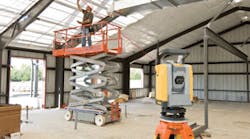Increased productivity and accuracy can add to the bottom line of almost any business. Trimble MEP, a new field layout software solution from Sunnyvale, Calif.-based Trimble, is helping mechanical, electrical, and plumbing contractors meet this objective by allowing greater control of construction layouts.
Using the software with the company's SPS610 Robotic Total Station and a handheld controller permits users to take points from a digital CAD design file or 3D building information model (BIM) into the field to simplify the layout of conduit, pipe, duct, and cable trays. In addition, the product enables just one person to handle complex layouts — whether on the floor, wall, the top of the deck, or directly on the underside of the deck.
“Using specific language and work flows inherent to trade applications, Trimble MEP maximizes the existing skill sets of field personnel, instead of requiring personnel to adapt the position technology to their specific tasks,” says John Inman, Trimble's building construction business development manager.
According to Inman, the software is designed for contractors performing applications such as layout of conduit and pipe sleeves for floor or wall penetrations; layout of anchors for ducts and pipe hangers; placement of equipment; creation of control lines and points; and collection and reporting of as-built information.
“Today's contractors face tighter project schedules with less time to complete their tasks,” notes Inman. “Compounding errors are inherent in traditional layout methods, especially in buildings whose designs contain curves and odd angles. Trimble MEP uses the established job site control to position every point independently, therefore eliminating compounding errors that can result in rework and schedule delays.”
Kevin Bollendorf, director of engineering services for Westphal & Co., an electrical construction firm headquartered in Madison, Wis., agrees that the software offers ample time savings.
“By using the product, we believe we have cut the time it takes to lay out items to be installed in the field by about 50%,” he says.
According to Bollendorf, his firm researched several other total station software providers but ultimately chose Trimble because of the software's ability to import and export information easily and accurately from AutoCAD.
“This has worked out well in laying out concrete embeds, high ceiling light fixture installations, and sleeves,” he says. “Not only has our field accuracy increased, but so has the productivity of our installations. This technology enables us to become more flexible as the job-site schedules get compressed and customer demands increase.”
Furthermore, the software allows e-mail transfer of design data and daily progress updates using wireless communications between the office and field.
The system is priced at approximately $30,00 to $35,000, depending on the accessories, software, and level of on-site training desired.
For additional information, visit www.trimble.com/mep.



